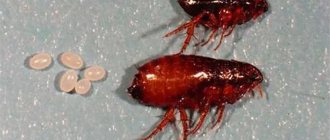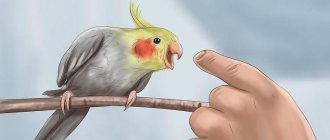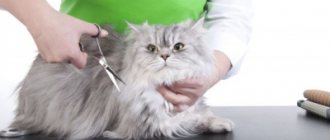Scratching in cats is not considered a big problem, but only until the wounds are bloody or cover a large area. The speed of development of events is also frightening, since most often the cat itches a little, and after 10–12 hours bleeding wounds appear on the pet’s skin. Such a horrifying picture does not pose a serious danger as long as the wounds are not infected. The cat is in pain, nervous, eating poorly, anxious, how can you figure out what to do?
Treating scratches at home
Most often, the owner decides to observe the development of events; in the end, the cat may itch due to nervousness. If the cause is not determined correctly, the situation worsens and scratching becomes painful. The progression of the disease can be determined by the reaction of the animal, which does not allow the scratches to be examined or simply hides.
There is another scenario for the development of events - the external scratching is delayed, and the infection that has “settled” on open wounds goes into the deeper layers of the skin. This happens for two reasons - complete ignorance of the problem or treatment of the animal’s skin at random.
Simply put, when you see a scratch or scratch, you should not smear it with all the ointments that can help; it is better to adhere to the standard treatment regimen or consult a doctor. If abscesses and boils form, you need to consult a doctor, since for recovery you need to remove the infection from the deep layers of the skin as quickly as possible. If the veterinarian doubts that the cat's immune system is functioning at full strength, non-steroidal anti-inflammatory drugs may be prescribed.
Note! Scratching is called a hot spot because the body temperature in the affected areas is usually higher than the base temperature.
If the inflammation does not seem extensive or painful, treatment at home comes down to preventive measures. If you do not allow infection to occur, and the cause of scratching does not lie in illness, the wounds will heal within a few days.
To disinfect and relieve discomfort, wounds are wiped with non-alcohol tincture of calendula. It is best to buy a collection of herbs and make a decoction yourself. If you need to act quickly, and only an alcohol solution is on hand, you need to fill it with hot water or boiling water so that the alcohol evaporates as quickly as possible.
Local discomfort is successfully relieved with cool lotions. For cooling, you can use herbal decoctions - oak bark, calendula, chamomile , etc. You need to be careful with lotions because wounds need to dry out to heal. By the same logic, scratches should not be bandaged or sealed. If the cat actively licks wounds, use an Elizabethan collar or follow the regimen prescribed by the veterinarian.
Note! If a cat has scratches on its head, the use of a collar is mandatory and the main danger is not infection of the wounds, but in causing a traumatic brain injury during scratching with its paws.
If you want to rid your cat of scratching, you need to heal not the wounds, but the reasons for their appearance. The word comb comes from “to itch”, which means that the cat is bothered by itching. You need to understand that when the skin just itches, the animal does not tear the skin to the point of wounds.
The cat has sores on the neck, on the head: Treatment of fungal infections
- Local treatment in the form of ointments. (Yam, Sanoderm).
- Local treatment using Fungin spray.
- Use of the therapeutic vaccine Vakderm, Polivac.
- Bathing with antifungal shampoos once every 3 days for 6 weeks.
- For generalized lesions, antifungal drugs are used orally ( Introconazole , Terbafine).
- Complete balanced feeding.
- Use of vitamin and mineral supplements to feed.
- Avoid scratching and licking (wear a collar).
- In long-haired animals, it is advisable to clip the affected areas.
- Washing with vinegar water and horsetail infusion.
Diagnosis of scratching and itching
Itching is probably one of the most unpleasant sensations that can only be relieved by scratching. It has been proven that a person can become psychotic if they experience itching and cannot scratch themselves. Itching in an animal is a clear sign of skin damage, although it can occur before obvious symptoms appear. In veterinary medicine, as in human medicine, itching is distinguished depending on its nature:
- Localized – one or more specific places are itchy, for example, scratching appears only on the face or on the neck and cheeks.
- Generalized – when the cat’s entire body itches.
Prevention
Both purebred cats (British, Scottish Fold, Maine Coon) and outbred pets are susceptible to sores and scratches due to itching around the ears, on the stomach and back, and limbs. To protect your pet from skin diseases, you should protect your cat from contact with sick animals and carry out regular treatment with flea and anthelmintic agents. Cosmetics for care and food should be chosen of high quality, with natural additives. Purchase industrial food products that are hypoallergenic. Carry out hygienic cleaning of ears and eyes with special means. It is recommended to periodically disinfect the sleeping area.
Causes of scratching
The first thing the doctor will do is examine the animal for the presence of parasites. Flea scratches appear all over the body, most often on the cheeks, neck, chin and at the base of the tail. In most cases, even if the animal has recently been treated, parasites are the cause of the itching.
The cat itches because the saliva of blood-sucking parasites always causes an allergic reaction. If you have ever been bitten by a flea or tick, you know that the bite itself is not felt, but afterwards it itches a lot. Flea saliva, injected under the skin, acts as a pain reliever, but since it has a protein base, after some time an allergic reaction occurs.
Note! The development of a flea allergy does not always imply the presence of a large number of parasites; for cats with sensitive skin, a few bites are enough for scratching to appear.
The next most popular reason is microscopic mites. Itching from mites is incomparably stronger than allergic; the area affected directly depends on the method of parasitism. For example, when infected with ear mites, a cat scratches the skin near the ear, forehead and back of the head within 24 hours. The subcutaneous mite can settle on the back, body, under the arms or even on the tail. To confirm or refute the diagnosis, a scraping is taken from the damaged skin for laboratory examination.
During laboratory analysis, scrapings are also checked for the presence of spores, which will indicate a fungal infection of the skin. Cats, dogs and people constantly have fungi and microorganisms living on their skin; not all of them are friendly, but the symbiosis is designed so that the bacteria do not attack the host. When the level of immune defense drops or an active, unfriendly culture is introduced, the cat may develop microsporia, which for many is more commonly called lichen.
Statistically, cats are more likely to get ringworm, but are practically not susceptible to other skin ailments. If the diagnosis is confirmed, the veterinarian will prescribe a course of treatment. Typically, treatment for ringworm involves injections or oral medications. Scratching should be smeared with antiseptic ointments with an antifungal effect.
Important! The symptoms of itching and allergic skin reactions are very similar (redness of the skin, itching, scratching), but are treated differently.
Preventive actions
Preventive measures that help prevent the development of ear diseases in cats:
- Systematic cleaning and examination of the ears. The procedure is carried out 1-2 times a week. A special spray helps remove sulfur and has a disinfecting and healing effect. The product must include natural ingredients. Antibiotics in this case can only do harm, so they are not used.
- The following measures are taken against parasites: drops are applied to the withers, a collar is put on the animal to repel fleas and ticks.
- Maximum accuracy when carrying out water procedures. When bathing your pet, you need to make sure that water does not get into the ears. It is recommended to plug them with cotton wool. You can't get your head wet.
- No drafts.
- Activation of the body's protective functions. Ear diseases often develop with weak immunity. It is necessary to enrich the animal's diet with foods rich in vitamins and minerals. Physical activity, lack of stress, and good nutrition strengthen the pet’s body.
A pet may scratch its ears for a variety of reasons. Often itching in the ears is the initial stage of any disease, so this symptom cannot be ignored.
Next
Health Cloudy eyes in a cat: causes, diagnostic methods, treatment
Allergies as a cause of itching and scratching
If all of the above reasons are excluded, the doctor will assume an allergy.
Food allergies
If you're lucky, the allergy will be food, that is, caused by eating foods or feed that are not entirely suitable for the cat. Food allergies are identified by taking a detailed history. It is important to remember what you fed your ward for the last 10 days, did you change the food, did you treat it from the table, etc. To alleviate the condition, the animal is transferred to a neutral diet and supported with antihistamines. How to recognize allergies in the video below:
Routes of infection
The most common route of infection with cat scabies is contact. The microscopic tick can easily jump from one infected animal to another. Moreover, it is absolutely not necessary to contact sick relatives. A cat can become infected from a dog, from another cat, or from birds - domestic or wild. Pigeons are especially prone to scabies.
This can happen anywhere: during a walk, at a veterinarian’s appointment, at an exhibition, on public transport. Small kittens often become infected from their sick mother during the period of cohabitation and feeding.
The second common route of transmission of parasites is through animal care items. You can pick up a tick from someone else's comb, brush, or bedding. The third is housekeeping clothes and shoes. A person can bring ticks into the house on their clothes or shoes.
Who is at risk
Most often people become infected with scabies:
- Animals with weakened immune systems.
- Exhausted cats.
- Pets in shelters and stray cats.
Stress and mental disorders
It is rare, but it happens that scratching in cats is associated with a mental disorder. Most often, the wounds resemble scratches, but are not them, since the cat is actively licking itself. Wounds form on the paws and shoulder blades. The size and depth of the wounds is rapidly growing, but despite the pain. the cat continues to lick itself.
Assumptions about neurosis are relevant if all of the above reasons could not be confirmed. The diagnosis is confirmed by prescribing a course of sedatives, if the cat begins to actively lick itself and the wounds begin to dry out - the reason is stress.
Precautions for fungal infections in domestic cats
The disease is anthropozoonotic – that is, transmitted from animals to humans and vice versa. Children and the elderly, as well as those weakened by other diseases, are most susceptible to infection with the fungus.
Therefore, if there are children, old people or seriously ill people in your house, then of course the most optimal solution would be to isolate the sick animal in another room until it has fully recovered.
If the inhabitants of your apartment are all adults and healthy people, then it will be enough to treat the cat’s skin with ointments, wearing gloves and a mask, carry out daily wet cleaning using antiseptics, iron the fabrics with a hot iron, and wash your hands.
What to do when a cat scratches its ear until it bleeds
Every cat must take care of itself. These animals are very clean and clean their fur, wash themselves often, and scratch their ears. But every owner should know what to do when a cat scratches its ear until it bleeds. This also happens. This occurs mainly due to ear diseases. Unfortunately, they happen quite often in animals. And the cat is trying to show you that something is bothering him, he feels discomfort and pain. He cannot solve this problem on his own, and the owner’s task is to detect health problems and various diseases in a timely manner.











